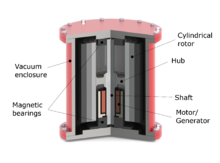Flywheel storage power plant
A flywheel storage power plant used for energy storage, the flywheel energy storage . As a comparatively small storage power plant with peak outputs of up to 20 MW, it can, to a certain extent, stabilize island networks in terms of the network frequency and serve as a short-term compensation storage facility . In contrast to conventional storage power plants, such as pumped storage power plants with outputs of up to 1000 MW , the outputs of flywheel storage power plants range from a few kW to a few 10 MW. In this area of application, they are comparable to battery storage power plants .
Application examples
Possible areas of application are places where electrical energy has to be stored and released again, for example to compensate for fluctuations in the range of seconds in wind power and solar systems. These storage systems consist of individual flywheel storage systems in a modular design. Peak powers of around 150 kW can be absorbed or output per flywheel. By combining several such flywheel accumulators, which are individually housed in vacuum tanks buried in the ground, total outputs of up to a few 10 MW can be achieved. The electrical connection of the motors operated with low voltage takes place via a direct current intermediate circuit and the converter systems are comparable to systems as they are also used for high voltage direct current transmissions .
In a few vehicles, mostly prototypes, flywheels are used as an additional module for batteries, for example in buses from the 1970s, in order to store braking energy through recuperation. Flywheels are used in a pilot project on the tram in Zwickau . The braking energy is transferred electrically via the overhead line to the flywheels, which are located in containers on the edge of the rail. The tram in Zwickau can thus recover up to 200 MWh of braking energy per system per year.
BEACON Power operates a flywheel storage power plant with 200 flywheels with a total capacity of 5 MWh and 20 MW output in Stephentown, just outside New York. The units work at their peak at 15,000 revolutions per minute. The rotor of the flywheel consists of wound CFRP fibers that are filled with resin. The park is used for frequency control. This service is sold to the New York network.
The Stadtwerke München (SWM) put in a first pilot plant flywheels one to compensate forecast deviations from renewable energy. The system consists of 28 flywheels and has a capacity of 100 kWh and an output of 600 kVA . The rotor is made of carbon fibers, is in a vacuum and rotates at up to 45,000 revolutions per minute. The maximum power that the system can deliver is 1 MW. The response time of the system is in the millisecond range.
A flywheel storage power plant from Temporal Power Ltd. has been in operation in Ontario, Canada since 2014. used. It consists of 10 steel flywheels. Each flywheel weighs four tons and is 2.5 m high. The maximum speed is 11,500 revolutions per minute. The maximum output is 2 MW.
A 5 MW flywheel storage power plant from Temporal Power Ltd. is currently under construction on the island of Aruba . built.
Web links
Individual evidence
- ↑ Flywheel storage power plant in Hazle Township, Pennsylvania (USA), operator side beaconpower
- ↑ Power Electronics , representation of power electronics, operator side beaconpower
- ↑ zdf-video , ZDF - Planet E - Flywheel Storage, Minute 17:03
- ↑ cleanthinking.de BEACON Power, USA
- ↑ aachener-zeitung.de Stadtwerke München market Jülich Speicher
- ↑ ingenieur.de This flywheel stores wind energy
- ↑ thestar.com Ontario electricity gets taken for a spin
- ↑ issuu.com Innovative Flywheel Project Supports Aurba's Move to 100% Renewable Energy
